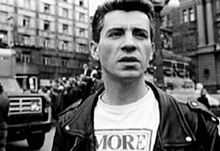Milan Mladenović
| Milan Mladenović | |
|---|---|
 | |
| Background information | |
| Born |
September 21, 1958 Zagreb, PR Croatia, FPR Yugoslavia |
| Died |
November 5, 1994 (aged 36) Belgrade, Serbia, FR Yugoslavia |
| Genres |
Art Rock Post-Punk New Wave |
| Instruments |
vocals guitar |
| Years active | 1977–1994 |
| Associated acts |
Limunovo drvo Šarlo akrobata Katarina II / Ekatarina Velika |
Milan Mladenović (Serbian Cyrillic: Милан Младеновић; September 21, 1958 – November 5, 1994) was a Serbian musician best known as the frontman of the Yugoslav art rock band Ekatarina Velika.
Early life
Born to Serbian father Spasa from Kruševac and Croatian mother Danica from Makarska, Milan's first years were spent in Zagreb, PR Croatia, where his father, an officer in the Yugoslav People's Army, was stationed at the time. Consequently, Milan grew up wherever it was that his dad's job took the family. In total, it ended up being three different cities. When he was six, Milan's family moved to Sarajevo where he spent a notable part of his childhood. Eventually in 1970, they moved to Belgrade just short of his 12th birthday. Once in Belgrade, Milan attended the Eleventh Belgrade Gymnasium in Lekino Brdo neighbourhood while simultaneously entering the circle of young people involved with music and arts.
Musical career
Limunovo Drvo and Šarlo Akrobata
With schoolmate Gagi Mihajlović, Mladenović formed a band called Limunovo drvo (Lemon Tree) that dabbled in melodic hard rock. The group changed lineups frequently, displaying a pretty limited creative potential until the arrival of bassist Dušan Kojić Koja and drummer Ivan Vdović Vd. Soon afterwards, they adopted a new musical direction (Novi talas) and changed the name to Šarlo akrobata. During this time Milan was musically very much fond of and inspired by Elvis Costello, Paul Weller, and Andy Partridge of XTC.
Šarlo akrobata released only one album, Bistriji ili tuplji čovek biva kad... in July 1981 and broke up soon afterward due to creative differences between Milan and Koja. The record is considered to be one of the best and most important albums of the Yugoslav New Wave music scene.
Katarina II and Ekatarina Velika
In late 1981 Milan and his former bandmate from Limunovo drvo Gagi Mihajlović (guitar) hooked up again to form Katarina II. In 1982 Margita Stefanović (keyboards), Bojan Pečar (bass) and Ivan Vdović Vd joined the band. After the self-titled, New Wave coloured debut album, Vd and Gagi left the band. Since Gagi claimed ownership of the "Katarina II" name, the band was forced to take another one. They eventually settled on Ekatarina Velika and released a self-titled album in 1985. The album was widely critically acclaimed and brought them wider attention. Their next album S' vetrom uz lice launched them to the very top of the Yugoslav music scene, where they stayed for a long time, releasing a series of successful records. The concerts were jam packed and finally their music even made it on the state radio.
Final works
In 1992, Mladenović joined other Serbian musicians to form Rimtutituki project dedicated to the anti-war campaign. They released one single titled "Slušaj 'vamo".[1] In the spring of 1994, Mladenović recorded and released an album called Angel's Breath in Brazil together with his old friend Suba (Mitar Subotić).
Death
In August 1994, Mladenović discovered that he had pancreatic cancer. He died on November 5 in Belgrade, FR Yugoslavia and was buried at Novo groblje cemetery.
Legacy
Two streets in the capital cities of former Yugoslav republics bear Mladenović's name. A street in the Belgrade neighborhood Zemun Polje was named after him in 2004,[2][3] as well as a street in the Podgorica neighborhood Zabjelo in 2007.[4]
Since July 14, 2011, the forecourt of the Belgrade Youth Center bears the name "Milan Mladenović Place".[5]
On October 25, 2012, in Zagreb (Croatia), one street was named after Milan Mladenović. [6]
Studio discography
With Šarlo Akrobata
- Paket aranžman (1980) - with Električni orgazam and Idoli
- Bistriji ili tuplji čovek biva kad... (1981)
With Katarina II/Ekatarina Velika
- Katarina II (1984)
- Ekatarina Velika (1985)
- S' vetrom uz lice (1986)
- Ljubav (1987)
- Samo par godina za nas (1989)
- Dum Dum (1991)
- Neko nas posmatra (1993)
With Angel's Breath
- Angel's Breath (1994)
External links
| Wikimedia Commons has media related to Milan Mladenović. |
- Ekatarina Velika On-Line - fansite (Serbian)
- A friend from Osijek (Croatian)
- Mladenović's grave at Belgrade Graveyards' website
- Mladenović's grave at Finde a grave' website
- Danas 13 godina od smrti Milana Mladenovića, Blic, November 5, 2007
- PRIČA O LIMUNOVOM DRVETU
- PRIČA O LIMUNOVOM DRVETU II
References
| |||||||||||||||||||||||
| |||||||||||||||||||||||
|